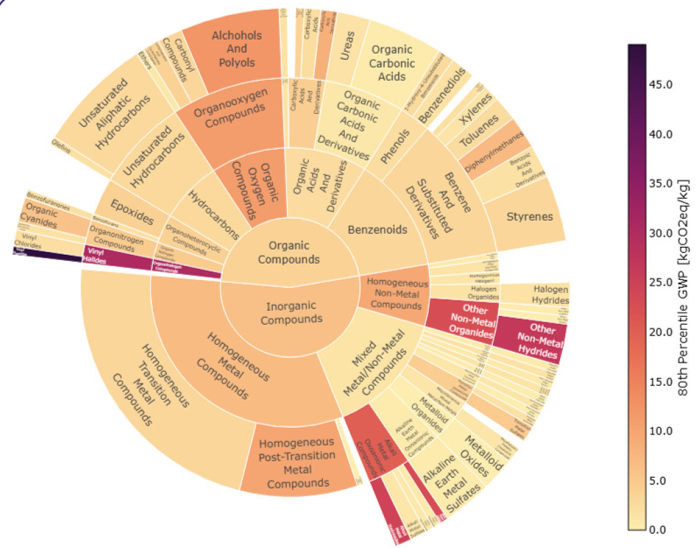What if a chemical substance does not have an LCI in Idemat?
Find proxi s for 350.000 chemicals.
There are about 400 chemicals (including plastics) in Idemat. That are the common “building blocks” in the chemical industry. However, there are more than 300.000 commercial available chemicals in REACH (registered within the EU), and more than 1.1 million names in the system of Classify. So what to do if you encounter a chemical that is not in Idemat?
Students at the Delft University can have a look in Ecoinvent, since there are about 700 chemicals in total, but there is still an enormous gap with the commercial available chemicals.
There are two methods to deal with this gap:
(1) applying the precursor (or the last chemical reaction)
(2) applying the Classyfire tables
Note: skip chemicals that are less than 0.1% weight of the Bill of Materials (in contrast to metals that always must be included), since the carbon footprint of their production can be ignored (in contrast to the emissions of chemicals)
1. Applying the precursor (or the last chemical reaction)
The most common applied trick of LCA practitioners is to take the precursor, since many chemicals are derived from common chemicals, applying only small modifications. This can be done when the last reaction is exothermic, which is true in the majority of cases. The required electricity for pumping, mixing, and other “unit operations” is often negligible in comparison to the energy that is required to produce the precursor form cradle to gate.
A variant is to take the last reaction, when data of the reactants are known. An example:
NH3 + HCL – > NH4CL (ammonium chloride), where 0.318 kg NH3 + 0.682 kg HCL -> 1 kg HH4CL
this reaction is endotherm and requires 277 kJ per kg NH₄Cl
These data enable a calculation with Idemat
2. Applying the Classyfire tables: for proxies of 360.000 chemicals
The Classyfire system gives the taxonomy (classification) of more than 1.1 million chemical substances. To make the system operational in LCA, the 400 chemicals (exothermic) in Idemat have been grouped in classyfire subsystems. Each subsystems has the same chemical type of building block (a sort of precursor), so it is assumed that the LCA characteristics (e.g. the carbon footprint) are similar within a classyfire subsystem. See the figure below.
The Idemat tables show for each classyfire subsystem that has one ore more substances in Idemat, the eco-costs, CED, ReCiPe points, EF points, and TRACI scores.
A classyfire subsystem may contain 1, 2, 3, 4, or more chemical substances in Idemat. The result of the calculation of a classyfire subsystem is the average score of the substances in Idemat. The number of substances and the standard deviation are given in the description of the LCI line. As an example:
Anilides (n=4, std=0.24), total eco-costs = 1.92
where there are in Idemat 4 Anilides, and where 4 calculations result in an average of 1.92 euro eco-costs with a standard deviation of 0.24 euro.
In practice, these Idemat classyfire lines can be found in this Classyfire Table by search of the CAS number of the chemical you are looking for.
Note that you have not a 100% match, since only 360.000 CAS numbers (of the 1.1 million) have an Idemat Classyfire subsystem LCI
The stepwise procedure for finding the carbon footprint or eco-costs of a ‘chemical without LCI’ is:
chemical name -> CAS number -> Classyfire subsystem in the classyfire table -> carbon footprint or eco-costs in Idemat
copyright University of Washington


